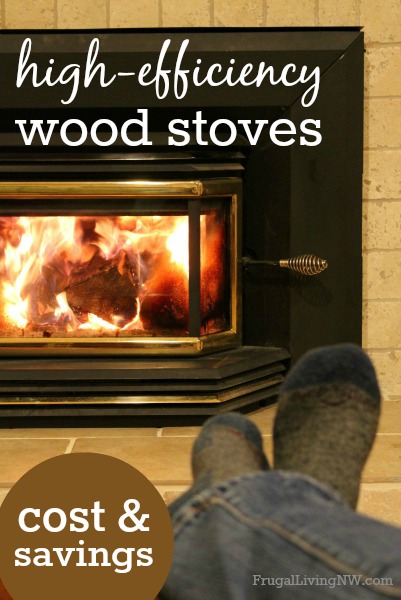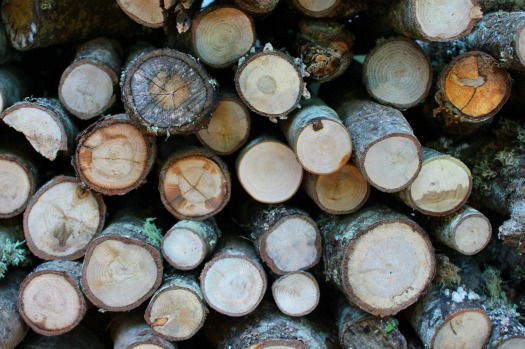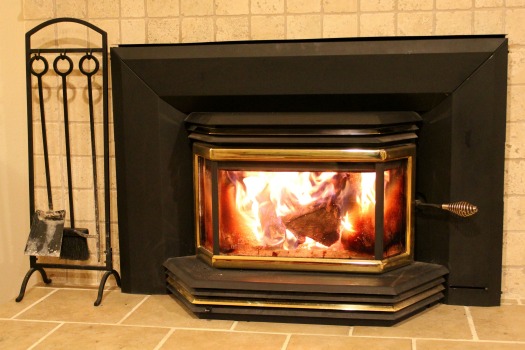
High-efficiency Wood Stoves: Cost & Savings
Last weekend, we got about 6 inches of snow at our house. My husband, like any respectable energy efficiency nut, wasted no time in breaking out his precious spray foam and foam board (recycled packaging, of course). He blocked out windows in our back bedrooms and sprayed foam into any nook and cranny that dared to leak air into the house. I even woke up one frosty morning to find all of our couch cushions stacked into our huge picture window. I don’t even bat an eye anymore. Seriously, this is just another day living with Ed.
We don’t always see eye to eye on these crazy projects, but there was one change we were both excited to make: swapping out our natural gas fireplace for a high efficiency wood stove insert. In this post, I’ll break down the costs and savings, as well as provide a few details about what is involved in a switch like this.
We knew as soon as we bought the house that getting a wood-burning stove would be near the top of our to-do list. The house had a gas fireplace with a wood-stove compatible chimney chase. Not every gas fireplace would be a simple conversion; it must meet certain requirements. Check with your local building permit office for more details on this.
Our first step was to take measurements of our space and decide what we wanted in a wood stove. We stopped at a few stove stores (many sell used) and scanned several websites so we had a good idea of the styles, options, and price points available.
Ultimately, we landed on Craigslist. I was actually surprised at the number of Craigslist ads that fit our search. My guess? Many people are converting to natural gas fireplaces. Different strokes for different folks. We pursued a few listings before finding the perfect fit, an Osburn 2200. New, this stove would cost around $2,200.00. We purchased ours for $450. It was in sad shape, having been stored outside for over a year. My smartypants husband looked past the rust, paid cash, and heaved it into the car.

Next up, getting a permit. To meet code, you’ll need to apply for a permit and have an inspection after you install a wood stove. Our county has an $85 minimum for all mechanical permits, so we decided to apply for two projects at the same time: installing a wood stove and replacing our water heater. The total came to $95. The wood stove permit alone would have been around $93. This will differ by county so check with yours for accurate prices.
My husband found a sandblasting service in the online yellow pages. For $80, the man picked up our (heavy!) stove, sandblasted all the rust off it, and returned it to our house within four days. Ed took it to work and painted it with High-Heat Spray Paint. We also purchased a new door seal kit from a local farm-supply store and Insulated Stove Pipe from Amazon and Craigslist.
We built out our hearth to meet code (minimum 16″ from front of door). We matched the small tile that was currently installed and chose clearance tile for the hearth section, so this was an incredibly inexpensive addition. Then we installed the like-new stove and stovepipe. Schedule an inspection with the county. Done.
We fired it up for the first time on Christmas Eve. My husband finished the final steps minutes before our first guests arrived for dinner. Our wood stove has been going strong ever since. We even completely turned off our furnace!
And the savings? $139 in the first month alone. Our natural gas bill, using our forced air furnace, for December was $168.75 (the previous owners were closer to $250/month). Our heating bill for January was $36.24. Obviously the savings will decrease as the months get warmer, but we are really happy with the return we are already getting on this long-term investment.

So, here’s the breakdown of what we spent for our wood stove installation:
Wood stove installation permit: $93
Used wood-stove: $450
Used & new stove pipe: $315
Door seal kit: $20
Sandblasting & high-heat paint: $120
Grand total: $998
While many see a wood stove as more work (it is!), it is more than worth it to us, both from a savings and a satisfaction standpoint. We love the look and heat and savings of a wood-burning stove. Since we normally heat our home 8-9 months out of the year, our wood stove will pay for itself in just over a year while heating our home for years and years to come.
Hey, Ed! I need one of these Black Canvas Fireplace Log Totes (Amazon). Paired with clogs, corduroy slacks, and a cream-colored cable knit sweater, I would look like I just stepped out of an LL Bean catalog. Running out in the rain wearing wearing my usual wood-gathering attire of yoga pants, fleece jacket, and flip flops, would produce a slightly less stellar look, but I’d still get the job done.
This post may contain affiliate links. See the disclosure policy for more information.

Wood stoves can reduce your electric bills by an average of $64 to $255 per year. A gas fireplace typically has a 58 to 85 percent efficiency rating. It also produces minimal smoke and creosote pollution, making it a more eco-friendly option.
I made a wood carrying bag for my husband for Christmas 2012. I used duck cloth and belting from JoAnn Fabrics (with coupons, of course!). It cost less than $10 and works great.
Also, if you know of any reputable people who sell wood, we’d love to hear. We’ve had more than one person tell us how dry and seasoned their wood is … until we try to burn it and realize how green it is. 🙂
Simple solution – buy a moisture meter! They can be had for about $ 30 and come in handy for other things, such as finding leaks etc. You could also keep buying or getting your wood a year ahead of time, we always have at least a 2 year window going.
I’m curious where you get your wood from/how much you spent on it? We have a wood stove, but have found that the cost of wood almost negates the savings.
Sam, call your local Tree Service company, they always have wood they are willing to give away, or you may have to pick it up at the place where they are trimming. We have never paid for wood.
We installed two pellet stove inserts in our 2000 sq. ft. house… one upstairs, one downstairs. The house was built with forced air downstairs, radiant heat from the ceilings upstairs. One insert was a closeout, the other a gorgeous Craigslist find… replaced with natural gas and wanted it out of his garage. We cut a vent near the fireplace upstairs so we could use the downstairs unit to heat both floors in warmer weather. During the coldest months, our electric bill dropped by as much as $250. (Blown in roof insulation also helped.) The house warms fast, and our feet actually got warm. Our pellet costs were around $440 per year. We’d buy about 2 tons during the fall sales and make sure we were buying high efficiency brands. (Husband is an energy geek.)
When we built a new home, we installed a freestanding soapstone stove. These are not cheap, but a worthwhile investment in a new home or complete remodel. They are super high efficiency. A daily fire heats the stone enough to maintain the heat in the house with minimal support from traditional heating systems. We buy logs (mill rejects) at around $60 a cord. My husband spends a good amount of time splitting, enough so we invested in a hydraulic splitter. Bonus… after a fire, you can bake in the oven above the stove. Perfect for pizza!
We love our wood stove, and the cleaning is an easy do. My husband bought the chimney brushes and cleans ours regularly. Though the cat goes insane, with the sound of the metal brush against the metal stovepipe. LOL.
We live 50 miles northwest of Portland and when we do have to purchase firewood, it’s alot less than the Portland area.
After $400+ mo (about $3600/yr to our electric/gas provider) heating bills while keeping our house at like 62 we decided to put in a pellet stove. The stove was a refurbished model so we spent like $575 and our placement allowed us to pipe fairly right out through the wall. All together we spent just over $1000.
We spend about $400-500 on pellets a year and have averaged about $1300 ($90/mo yr round + a little more in the really cold months) a year to our electric/gas company – and our house is actually WARM, lol.
You forgot the cost of wood (though I bet you get it free?). Also there is a minimal cost of electricity if your stove has a fan to push more heat out.
Your comment made my husband a happy man. He could crunch numbers on this topic all day long. His answer:
Our insert style wood stove has a blower motor that greatly increases the amount of heat entering the house that would otherwise escape up the chimney. Running at full power it uses 21 cents/day. That will all go away next year of course when I perfect the addition of a steam engine driven off of some of the heat in the exhaust gas. In the end, it’s pretty much a wash by not running our HVAC blower motor (or having our furnace on at all).
We carry our wood with a reuseable grocery bag but we slit the sides open. Super strong and cheap.
Just remember to have you chimeny swept regularly. My brother just had a big chimney fire. Fire dept showed up, house filled with smoke when they sprayed it. Yuck. And dangerous.
I love that you converted to wood heat! We were fortunate enough to buy a home that already had a free standing wood stove installed. It heats our home very quickly and we have never paid a dime to heat our home (seriously!). It is more work, but well worth it. Cheers to keeping toasty the frugal way!